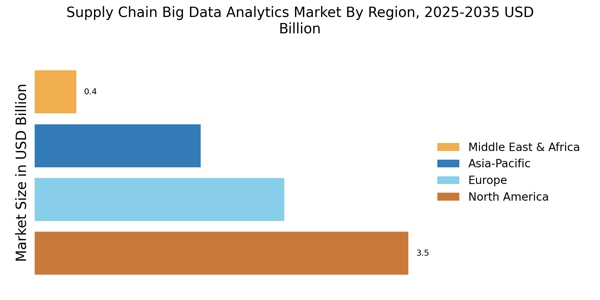Emergence of Predictive Analytics
The emergence of predictive analytics is transforming the Supply Chain Big Data Analytics Market. Companies are increasingly leveraging predictive models to forecast demand, optimize inventory levels, and enhance customer satisfaction. This shift towards predictive analytics is driven by the need for proactive decision-making in supply chain management. Studies suggest that organizations utilizing predictive analytics can improve their forecasting accuracy by up to 25%. As businesses strive to meet customer expectations while minimizing costs, the adoption of predictive analytics is expected to accelerate, thereby propelling the growth of the Supply Chain Big Data Analytics Market.
Increased Focus on Risk Management
In the current business landscape, the emphasis on risk management is intensifying, significantly impacting the Supply Chain Big Data Analytics Market. Companies are increasingly aware of the potential disruptions that can arise from various sources, including geopolitical tensions and natural disasters. Big data analytics provides tools to identify, assess, and mitigate these risks effectively. Research indicates that organizations employing data-driven risk management strategies can reduce their exposure to supply chain disruptions by up to 30%. This heightened focus on risk management is expected to catalyze the adoption of big data analytics solutions, as firms seek to safeguard their operations.
Rising Demand for Real-Time Data Insights
The Supply Chain Big Data Analytics Market is experiencing a notable surge in demand for real-time data insights. Companies are increasingly recognizing the value of immediate access to data, which enables them to make informed decisions swiftly. This trend is driven by the need for enhanced operational efficiency and responsiveness to market changes. According to recent estimates, organizations leveraging real-time analytics can improve their decision-making speed by up to 50%. As businesses strive to optimize their supply chains, the integration of big data analytics becomes essential. This demand for real-time insights is likely to propel the growth of the Supply Chain Big Data Analytics Market, as firms seek to harness data for competitive advantage.
Growing Complexity of Supply Chain Networks
The complexity of supply chain networks is escalating, which in turn fuels the growth of the Supply Chain Big Data Analytics Market. As companies expand their operations across borders and diversify their supplier bases, managing these intricate networks becomes increasingly challenging. Big data analytics offers solutions to navigate this complexity by providing insights into various supply chain components. It is estimated that organizations utilizing advanced analytics can reduce supply chain costs by approximately 15%. This capability to manage complexity effectively is likely to drive investments in big data analytics solutions, thereby enhancing the overall efficiency of supply chains.
Advancements in Data Processing Technologies
Technological advancements in data processing are playing a pivotal role in shaping the Supply Chain Big Data Analytics Market. Innovations such as edge computing and enhanced data storage solutions are enabling organizations to process vast amounts of data more efficiently. This capability is crucial for supply chain operations, where timely data analysis can lead to improved decision-making. It is projected that the market for data processing technologies will grow at a compound annual growth rate of over 20% in the coming years. As these technologies evolve, they are likely to further drive the adoption of big data analytics in supply chains, enhancing overall operational performance.


















Leave a Comment